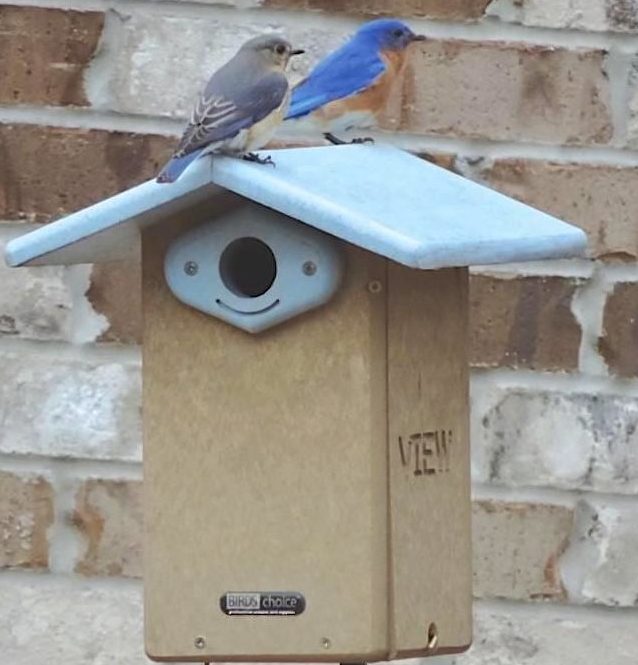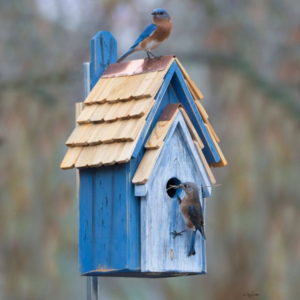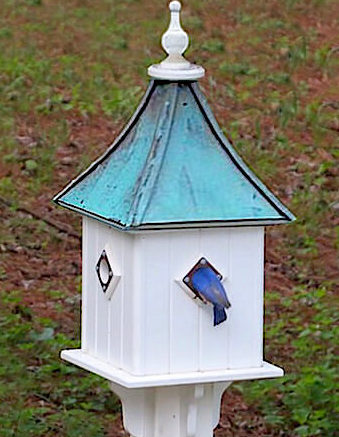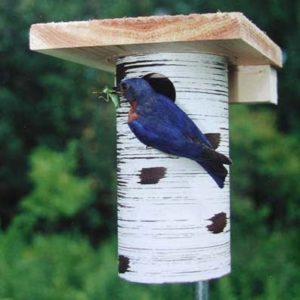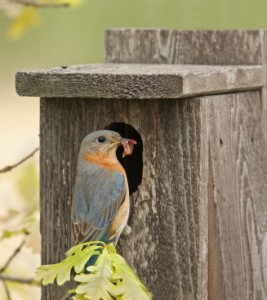-
Now’s the Time for Bluebird Houses!
They’ve started already, in the Southeast and further North, lots of folks are reporting first nests and first eggs laid in their bluebird houses. It’s one sign of springs’ arrival… bluebirds are house hunting!
Bluebird landlords (or folks who monitor bluebird houses) are eagerly awaiting the first clutches. Weather can be a tricky factor with late winter/early spring broods as natural food is still scarce. Bluebirds’ diets may be supplemented with meal worms, suet, shelled peanuts and sunflower hearts to help brooding birds cope with frigid or extremely wet weather.
Find the most handsome bluebird houses for all tastes, most are approved by the North American Bluebird Society (NABS). A house with side door makes for easy monitoring, as does the famous Gilbertson Nest Box.
High quality and USA made, find durable cedar, recycled plastic (or poly-lumber) and stunning vinyl bluebird houses with copper roofs. Standing the test of time, bluebirds will return to these fine digs year after year should fledges be successful.
Yes… monitoring is highly recommended to help keep bluebirds safe.
No… you won’t disturb them if you tap on the birdhouse first, steer clear of busy feeding times (dawn and dusk) and especially refrain prior to fledge time (about 19 days after hatching). The latter may scare babies into an early fledge for which they are not fully prepared.
Check out the website Silais.org for a wealth of information on bluebirds and other native cavity-nesting birds. Every question will be answered on this addictive site!
If you don’t have a blue bird house up yet… don’t fret. But now’s the time! Blues will brood two, three and sometimes even four clutches per season. Open space is best with tress or fence line nearby for bluebirds to perch, hunt insects and guard their nests. Fresh water in a birdbath always entices feathered friends too!
So what are you waiting for? It’s time to get your bluebird house on! -
Monitoring blue bird houses is starting early
Because of the mild winter, everything “spring” is happening early. Budding trees are flowering and bulbs are blooming, this means nesting season is underway! And we’ve been slammed with orders, not to mention a spring newsletter… yikes! So this guest post is by my room mate, Tango Dressage, kindly helping out 🙂
Watching blue bird houses is starting early! I only know this because every day my roommate, Beth (The Birdhouse Chick) grabs her binoculars and looks with anticipation to the blue bird houses to check for signs of nesting. It’s a yearly ritual that she has fostered by maintaining blue bird houses and feeders, and providing live worms (yes, we have worms in our refrigerator) to attract them to the yard.
It’s not just the bluebirds though, most all wild birds are welcomed and catered to. The bins on the screened porch store several different types of seeds, nuts, and treats for every avian diet. Feeders are cleaned and filled daily (she’s got it down to a science). Several houses built for the needs of different birds are and maintained to ensure good nest sites too. The squirrels even have their own area with corn bungees. Fresh water is abundant, with heated baths for winter, and these cool leaf misters for hot summer days, it looks like a bird spa!
Until I moved here I knew little to nothing about birds. After three years, Beth’s passion for birds and caring for animals has given me a new perspective on her. I thought she was crazy opening an online birdhouse boutique before I really knew her. After seeing how passionate and knowledgeable about birds she really is, I would think she was crazy not to!
When you call you are not dealing with a clerk, every order is checked for quality, packed with care and any questions you have answered enthusiastically by someone that really cares that every product is durable and appropriate for your needs. I guess what I’m getting to is that when you deal with thebirdhousechick.com you’re not dealing with a “big company” or “entity” You’re dealing direct with the real birdhouse chick.
-
blue bird houses vacant?
Using recycled materials greatly helps the environment by reducing waste and keeping said materials out of landfills. It takes about 25 to 40 plastic milk jugs to produce a recycled bird house or feeder. These blue bird houses are NABS approved, (North American Bluebird Society) and create the perfect nesting site for Eastern Bluebirds. With such a large shortage of natural nesting cavities, why would a great nest site like this be vacant?
Several factors will deem successful habitat for birds, and pesticides are detrimental in successful clutches. Environment plays the biggest role in attracting birds, and while everything may be super green and manicured in your yard, it may not be good for your avian friends. Ingested through insects fed by adults, pesticides wreak havoc on developing nestlings. Although sometimes not harmful to the adults, they are deadly to nestlings. If clutches in an area repeatedly fail, the bluebirds are likely to abandon the spot and seek other habitat.
Predators will also discourage nesting. Roaming cats, raccoons, snakes and larger bully birds will drive bluebirds from a possible nest site. House Sparrows and Starlings (both non-native species) will kill adult bluebirds in the nest box, as well as nestlings, and even destroy eggs too. Unfortunately this is common practice. These invasive and destructive birds are likely the main cause for the bluebird’s demise in the 70’s and 80’s. Ever-shrinking natural habitat with fierce competition for available nest sites being the reason.
•Be sure that blue bird houses are erected in proper habitat. Open spaces are preferred, with perching spots for hunting insects.
•Predator guards on bluebird houses also increase chances of successful fledging.
•Keep roaming cats indoors, or ask your neighbor to keep their cat out of your yard.
•Fresh water will entice bluebirds and others.
•Remove old nests (away from the area) after birds have fledged. A blue bird house with an old nest will not be used by another pair of bluebirds seeking a nest box.
•Supplemental feeding (with live mealworms) helps parents raise their young.
•Absolutely… quit the pesticides.

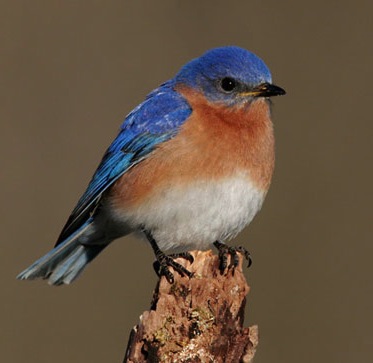 They’ve started already, in the Southeast and further North, lots of folks are reporting first nests and first eggs laid in their
They’ve started already, in the Southeast and further North, lots of folks are reporting first nests and first eggs laid in their 